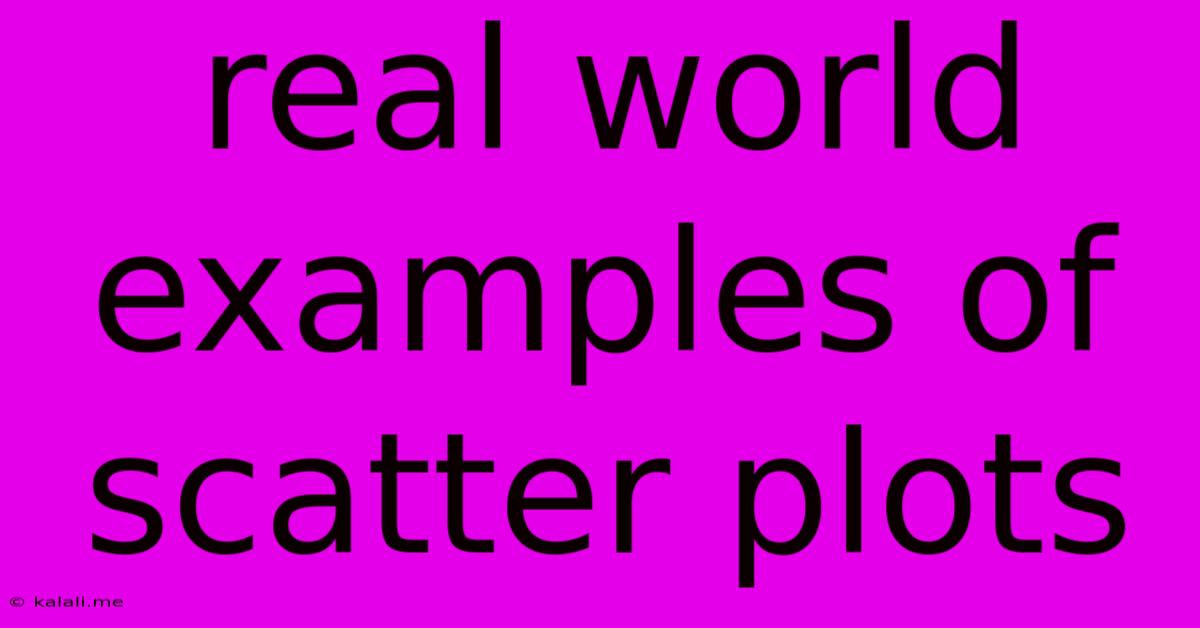Real World Examples Of Scatter Plots
Kalali
May 09, 2025 · 4 min read

Table of Contents
Real-World Examples of Scatter Plots: Unveiling Hidden Relationships in Data
Scatter plots are a powerful visualization tool used to explore the relationship between two numerical variables. They display data points as dots on a two-dimensional graph, with each dot's position representing the values of the two variables. Understanding how to interpret scatter plots is crucial for analyzing data across various fields. This article will explore several real-world examples illustrating the utility and interpretation of scatter plots. We'll delve into how these plots reveal correlations, trends, and outliers, providing valuable insights for decision-making.
What Makes a Scatter Plot Useful?
Before diving into specific examples, it's important to understand why scatter plots are so effective. They allow us to quickly identify:
- Correlation: Do the variables move together? Is the relationship positive (as one increases, so does the other), negative (as one increases, the other decreases), or is there no discernible relationship?
- Strength of Correlation: How closely do the points cluster around a line? A tight cluster indicates a strong correlation, while a scattered distribution indicates a weak or no correlation.
- Outliers: Are there any data points that significantly deviate from the overall pattern? These outliers can indicate errors in data collection or represent unique circumstances.
- Trends and Clusters: Are there distinct groups or patterns within the data? This can reveal subgroups or different relationships within the overall dataset.
Real-World Applications Across Diverse Fields:
Let's explore some compelling real-world applications of scatter plots:
1. Economics and Finance:
- Stock Prices vs. Interest Rates: A scatter plot can illustrate the relationship between a company's stock price and prevailing interest rates. A negative correlation might suggest that higher interest rates lead to lower stock prices.
- GDP Growth vs. Inflation: Economists use scatter plots to analyze the relationship between a country's Gross Domestic Product (GDP) growth and inflation rates. This can help identify potential trade-offs between economic growth and price stability.
- Consumer Spending vs. Disposable Income: A scatter plot can visually demonstrate how changes in consumer spending relate to changes in disposable income.
2. Healthcare and Medicine:
- Blood Pressure vs. Age: A scatter plot can reveal the relationship between blood pressure and age, helping identify potential trends and risk factors. This is useful for preventative medicine and public health initiatives.
- Dosage vs. Therapeutic Effect: In pharmaceutical research, scatter plots can illustrate the relationship between drug dosage and the therapeutic effect. This helps determine optimal dosage levels.
- Height vs. Weight: A simple yet effective use of scatter plots in healthcare is to visually represent the relationship between a patient's height and weight, allowing for easy identification of potential weight issues.
3. Environmental Science:
- Carbon Dioxide Emissions vs. Temperature: Scientists use scatter plots to analyze the relationship between carbon dioxide emissions and global temperature, providing visual evidence of climate change.
- Rainfall vs. Crop Yield: Agricultural scientists can use scatter plots to examine the relationship between rainfall and crop yield, optimizing irrigation strategies.
- Pollution Levels vs. Proximity to Industrial Areas: A scatter plot can illustrate the correlation between pollution levels and the distance from industrial zones, helping to inform environmental policies.
4. Education:
- Study Hours vs. Exam Scores: A classic example, this scatter plot demonstrates the relationship between the number of study hours and exam performance. It can reveal whether increased study time leads to improved scores.
- Attendance vs. Grade: A scatter plot can show the relationship between student attendance and their final grades, helping educators identify factors contributing to academic success.
Interpreting Scatter Plots Effectively:
When analyzing scatter plots, consider these factors:
- Look for trends: Do the points suggest a linear relationship (a straight line), a curved relationship, or no relationship at all?
- Consider the correlation coefficient: This numerical value quantifies the strength and direction of the linear relationship (-1 indicating a perfect negative correlation, +1 a perfect positive correlation, and 0 indicating no linear correlation).
- Identify outliers: Points that fall far from the overall trend should be investigated further to determine if they represent errors or significant exceptions.
Scatter plots are a valuable tool for exploring relationships within data. By understanding how to create and interpret them, you can uncover hidden patterns and make data-driven decisions across various fields. Their versatility and ease of understanding make them an indispensable tool for data analysis and visualization.
Latest Posts
Latest Posts
-
How To Graph A No Solution
May 09, 2025
-
Factoring A Quadratic With Leading Coefficient
May 09, 2025
-
Convertir 70 Grados Fahrenheit A Centigrados
May 09, 2025
-
What Is 144 Cm In Feet
May 09, 2025
-
In An Experiment The Variable Is Manipulated By The Experimenter
May 09, 2025
Related Post
Thank you for visiting our website which covers about Real World Examples Of Scatter Plots . We hope the information provided has been useful to you. Feel free to contact us if you have any questions or need further assistance. See you next time and don't miss to bookmark.